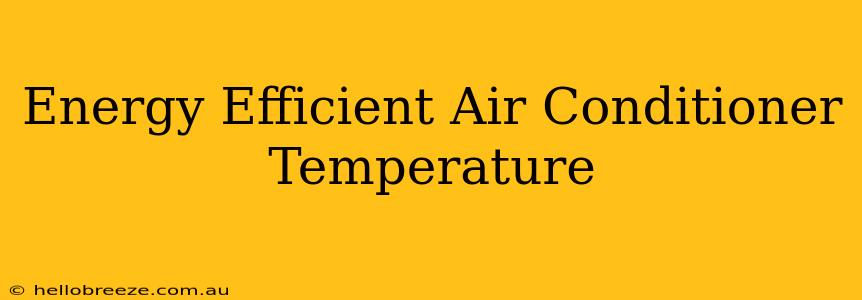Summer's heat can be brutal, but keeping your cool shouldn't break the bank. Finding the right air conditioner temperature is crucial for both comfort and energy efficiency. This guide will help you discover the ideal temperature setting for your AC unit, saving you money and reducing your carbon footprint.
Understanding the Relationship Between Temperature and Energy Consumption
The hotter the temperature you set your AC to, the harder your unit has to work. This increased workload translates directly to higher energy consumption and a bigger electricity bill. Conversely, setting your AC too low doesn't necessarily make you more comfortable; it simply wastes energy.
The Goldilocks Zone: Finding the Right AC Temperature
The ideal air conditioner temperature is often debated, but most experts agree that 78°F (26°C) is a good starting point for most people. This temperature provides adequate cooling without overly straining your system. However, personal preferences and health conditions can influence this optimal temperature.
- For better sleep: A slightly cooler temperature, around 75°F (24°C), is often recommended for bedrooms.
- For those with health conditions: Individuals with certain medical conditions may require a cooler setting for comfort and well-being. Consult your doctor for specific recommendations.
- Consider your climate: If you live in an extremely hot and humid climate, you might need to set your thermostat slightly lower for comfort.
Simple Steps to Optimize Your AC's Energy Efficiency
Beyond temperature settings, several actions can significantly improve your AC's energy efficiency and reduce your energy bills:
1. Regular Maintenance is Key
Scheduling annual AC maintenance is crucial for optimal performance. A professional technician can identify and fix any issues that might be reducing your system's efficiency, like refrigerant leaks or clogged filters. Cleaning or replacing air filters every month is another simple yet effective way to keep your AC running smoothly.
2. Strategic Room Usage
Don't cool empty rooms! Close vents in unused areas to direct cool air where it's needed, maximizing efficiency and saving energy. Consider using programmable or smart thermostats to automate temperature adjustments based on your schedule and occupancy.
3. Leverage Natural Cooling
Use fans strategically to circulate air and create a wind-chill effect, reducing the burden on your AC. Open windows during cooler periods (morning and evening) to allow for natural ventilation. Close curtains and blinds during the hottest parts of the day to block direct sunlight and reduce heat gain.
4. Seal Air Leaks
Check for and seal any air leaks around windows, doors, and other areas where cool air might escape. Caulk and weather stripping can make a huge difference in overall energy efficiency.
Beyond Temperature: Smart Habits for Energy Savings
Remember that temperature is just one piece of the puzzle. By adopting these energy-saving practices, you'll maximize the efficiency of your air conditioner and enjoy a comfortable, cost-effective summer:
- Use ceiling fans: These can help circulate air and create a cooling breeze, allowing you to raise the thermostat setting.
- Cook outside: Using your oven or stovetop generates heat, which makes your AC work harder. Opt for grilling or salads on hot days.
- Unplug electronics: Many electronics continue to draw power even when turned off. Unplug them when not in use.
By understanding the relationship between your air conditioner's temperature setting and its energy consumption, and by implementing these simple yet effective strategies, you can significantly reduce your energy bills and contribute to a more sustainable future. Finding that perfect balance between comfort and efficiency will leave you feeling cool, calm, and collected—all while saving money.

